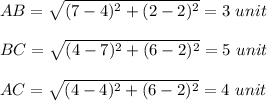Answer:
The area of △ABC is equal to the area of △DEF
Explanation:
On a coordinate plane, triangles A B C and D E F are shown. Triangle A B C has points (4, 2), (7, 2), (4, 6). Triangle D E F has points (negative 2, negative 1), (4, negative 3), and (4, negative 1).
How do the areas of triangle ABC and DEF compare? The area of △ABC is 1 square unit less than the area of △DEF. The area of △ABC is equal to the area of △DEF. The area of △ABC is 1 square unit greater than the area of △DEF. The area of △ABC is 2 square units greater than the area of △DEF.
Answer: The length of the sides of the triangle ABC are given below:

The area of triangle ABC is given as:
Area = 1/2 × base × height = 1/2 × 3 × 4 = 6 unit²
The length of the sides of the triangle DEF are given below:

The area of triangle DEF is given as:
Area = 1/2 × base × height = 1/2 × 2 × 6 = 6 unit²
The area of triangle ABC is equal to 6 unit² and the area of triangle DEF is equal to 6 unit² , therefore The area of △ABC is equal to the area of △DEF